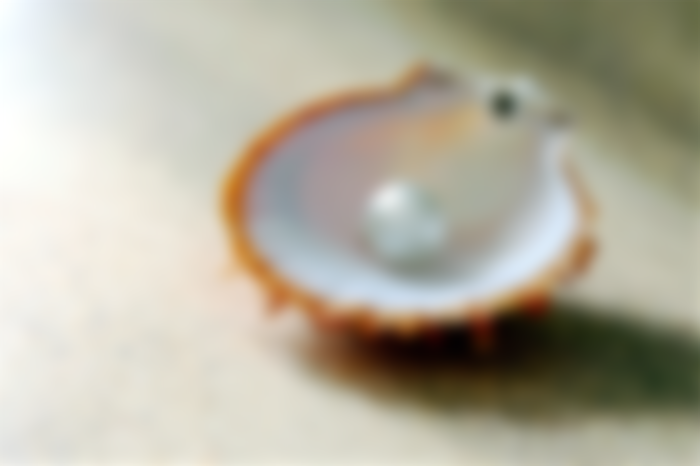Most gems are minerals, but a few are organic, derived from plants or animals. Here we will take a brief look at an animal gem, perhaps the most important of them all: the pearl, once the most precious gem on earth, with a value equal to a country.
"Pearls are worthless in the desert." (Indian Proverb)
"Those who wear pearls do not know how often the shark bites the leg of the diver." (African Proverb)
I.
Traditionally, the only way to get pearls was to dive and take up pearl mussels or pearl oysters, open them and pick out the pearl - if there was one! Mostly there was not. This was a hard and dangerous work, because the divers had to stay underwater very long and sometimes dive without equipment, too deep to be safe. All this made pearls rare and expensive.
After millennia of pearl diving in this way, most contemporary pearls are cultured. The method has been developed in Japan by Mikimoto [disputed by some sources]. A particle is implanted into the oyster, irritating there so it forms a pearl for protection. Cultured pearls can be of high quality but never reach the excellence of a well-grown natural pearl. The Chinese, however, have cultured pearls or rather half-pearls since during the 14th century. They would insert a small lead figure, for example a Buddha, as an irritant, and it was then covered with pearl tissue, nacre, or mother-of-pearl.
The oyster forms pearl tissue for protection, just like human skin becomes harder and thicker when under pressure or strain (most commonly on the feet). It has no known function beyond protection and encapsulation of alien, disturbing substances. Nacre, the material of pearls, also protects the animal from parasites and infections – although what we call pearls has nothing to do with that function.
II.
"And as she wept, her tears to pearl he turned,
And wound them on his arm, and for her mourned."
(Christopher Marlowe, Hero and Leander, 1598)
Pearls are surrounded by myths and legends, and they were always important symbols. Romans and Greeks associated them with the moon. A white pearl was "perfect purity". To the Greeks they meant love and were common at weddings. Sometimes they were also seen as solidified tears. There is a legend deriving the interest for pearls from man's fascination by the froth that gave birth to Aphrodite, and pearls were hallowed to this goddess.
In the Qur'an, paradise is described:
"The stones are pearls and jacinths; the fruits of the trees are pearls and emeralds; and each person admitted to the delights of the celestial kingdom is provided with a tent of pearls, jacinths, and emeralds; is crowned with pearls of incomparable lustre, and is attended by beautiful maidens resembling hidden pearls."
In Islam pearls symbolises perfection. They are sometimes considered as Adam's and Eve's tears of their sin. Allusions to pearls are legion in Islamic texts and not at least in poetry.
The Byzantines loved them, and their taste continued in Russia. In Medieval and Renaissance Europe they came to be Christian symbols of God's love, and several fine pearls are known by name, and were worn by Royalty, often as part of the crown jewels.
In the symbology of Alchemy, pearls were considered as tears from angles which fell into an oyster. The idea originally came from Persia. This is also where we find the oldest remnants of pearls, a necklace, in a 520 BC sarcophagus of a princess. But they were used earlier. There is an Indian legend of Vishnu giving the first pearl to his daughter, Pandaia, as a wedding gift; and in old Indian scripts, pearls abound. In China they are mentioned in a book, Shu King, from about 2300 BC. In Egypt, finally, mother-of-pearl was used as early as 5000-4000 BC.

III.
"He who searches for pearls should not sleep."
(Libyan Proverb)
For a long time, pearls were the most expensive gems on earth. Only when cultured ones became generally available, the price went down. A story tells how Cleopatra, the last of the Ptolemaic rulers of Egypt, wagered with Marc Anthony [Marcus Antonius] that she could consume the value of a country in one single meal. She won by crushing a pear-shaped pearl, dissolving it in a goblet of vinegar and drinking it. One single pearl had a value comparable to the wealth of a country! Supposedly the most expensive dinner in human history. Why did she do this? To prove that Egypt would be too expensive for the Roman legions to conquer! Egypt later came to be tied to the Roman empire anyway, even to become one of its corner stones.
Pearls come in almost all colours, depending on which mollusc they have grown in. The material is called nacre [mother-of-pearl] and it consists mainly of calcium carbonate and conchiolin. Trace elements cause different colours.
As a dietary supplement, ground pearls are strongly antacidic. They have an effect on ulcers and various intestinal or stomach problems. In Ayurvedic medicine, they are used for gastro-intestinal and mental ailments, and are connected to the heart chakra. In China pearl meal was used for a large number of ailments, and as an aphrodisiac.
Kokichi Mikimoto, who was the first who cultured pearls on a large scale, ate two crushed pearls per day as a dietary supplement. He is reported to have lived till 97, in good health. Is there a connection? Judge for yourself.
Pearls are weighed in "momme", originally a Japanese weight. It has been standardised to 1 momme = 3750 mg.
It can be useful to know how to detect the difference between real "wild" pearls, cultured ones, and imitations (plastics or glass). But it is not easy.
Roll the pearl between the tips of your thumb and ring finger, and also draw it along the biting edge of your foreteeth. Is it smooth? Then it is an imitation. It should be a bit grainy.
False pearls are too perfect in their round form and weigh too little or too much (plastic or glass interior). It is possible by inspection to study the inner structure, but to distinguish real from faked ones by that method is difficult, and to see the difference between cultured and wild pearls is close to impossible without scientific methods. The most accurate results are achieved by an X-ray fluorescence test and X-radiography. Both beyond the possibility of the average shopper.
Various light effects can be studied, and with some practice it is possible to determine a pearl's quality by that. At least as a contributory method. When they reflect light, the different layers of nacre cause a shimmering when the pearl is moved. So the pearl's lustre is important. A clearly reflecting surface, no fogginess, is a sign of a high quality pearl.
Pearls need care. They are sensitive to acidity – acids dissolve minerals; and the calcium carbonate of the pearls is a very acid-sensitive mineralic compound. They are also harmed by humidity and dryness. The various substances produced by clean skin are protecting the pearls, so wearing them is good for them, but putting them in touch with various cosmetics or residues of chemical hygiene products might be destructive. Always remember that they are organic matter, not insensitive and durable as a mineralic gemstone would be.

IV. ETYMOLOGY
"No oyster ever profited from its pearl."
(James Grover Thurber, The Philosopher and the Oyster)
The word "pearl" is based on Roman military slang "pirla", meaning little pear, alluding to the form of pearls; or from "perla", which was used as a translation of a Hebrew word meaning crystal.
These explanations are questioned by some etymologists, who claim the word has an unknown origin. Perhaps from "pernula", puzzlingly meaning "ham", or the leg of a mutton, and that should have to do with its shape. Far-fetched or not, judge for yourself.
An even more speculative derivation brings "pearl" from Tamil "paral". This is very questionable in my opinion, but one can never say impossible.
The oldest occurrence of the word "pearl" in English is from 1375, in Canterbury Tales by Chaucer.
Another word for pearl is "margarita", from which the name Margaret (in various forms) is derived. It stems from Greek "margaron, further from Armenian "markarit", originally from Persian "morvarid" It means "sea-daughter" and reflects the pearl's birth in the depth of the sea. Compare this to Aphrodite's birth from the froth of the sea.
There are also derivations from Sanskrit and Devanagari "manjari" [phool manjari], cluster of flowers, sometimes interpreted as pearl.
Mother-of-pearl, mater perlarum, is technically called "nacre", which is French, derived from Old Italian "naccaro", drum, which in turn stems from Arabic, and ultimately from Semitic root/stem "nqr"/"naqar-"; bore, shell.
Copyright © 2010, 2020 Meleonymica/Mictorrani. All Rights Reserved.
Here you can find my articles about History.
Interested in history, legends and myths, join my community History, Myths, Legends & Mysteries (be45).
You find all my writings on Read.Cash, sorted by topic, here.


I always thought cultured pearls were purely chemical derived. So they're still grownnin mollusks after all